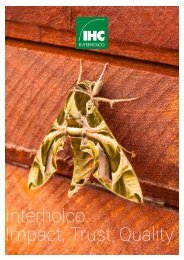Nomenclature Générale des Bois Tropicaux - 7ème édition
(english description below) Cette nomenclature est utilisée pour la mise à jour du 'Harmonized Code System' de l’Organisation Mondiale des Douanes. Dans la circulaire du 5 avril 2005, le Ministère de l’Economie, des Finances et de l’Industrie (France) reconnaît l’ATIBT comme « gardien du temple » de la nomenclature des bois tropicaux. La Commission Européenne mentionne la nomenclature de l’ATIBT comme document de référence pour la mise en œuvre du RBUE. Depuis 1954, l’ATIBT a établi et mis à jour une nomenclature des bois tropicaux faisant correspondre chaque espèce botanique avec un nom pilote reconnu internationalement. La détermination du nom pilote d’une essence est cruciale, car sa commercialisation dépend très largement de l’adoption de ce nom par le public. Le nom pilote assure la protection de l’appellation commerciale de l’essence et l’intégrité des propriétés qui lui sont attribuées, sans risque de confusion. The 1982 version of the general timber nomenclature has finally been updated as some of the 1,750 identified species, are no longer traded, while others, which were not previously included, are now on the market. The present revision has also integrated changes related to new taxonomy, in order to reflect the latest scientific developments. This Nomenclature has been used for the Harmonized Code System, updated by the World Customs Organization. The French Ministry of economy, finance and industry has given official recognition to ATIBT as the reference for the tropical timber nomenclature (NOR: PRMX0508285C of April 5th 2005). The European Commission refers to ATIBT nomenclature as a reference document for the implementation of the EUTR regulation. Since 1954, ATIBT has established and updated a nomenclature of tropical wood, linking each botanical species with an internationally recognized pilot name. A sigle wood species may have many common names; when trading across different countries, this may lead to confusion. Fixing the pilot name of a timber species is crucial, to protect the commercial denomination of the species and guarantee the veracity of the properties linked to that species, without confusion.
(english description below)
Cette nomenclature est utilisée pour la mise à jour du 'Harmonized Code System' de l’Organisation Mondiale des Douanes. Dans la circulaire du 5 avril 2005, le Ministère de l’Economie, des Finances et de l’Industrie (France) reconnaît l’ATIBT comme « gardien du temple » de la nomenclature des bois tropicaux. La Commission Européenne mentionne la nomenclature de l’ATIBT comme document de référence pour la mise en œuvre du RBUE.
Depuis 1954, l’ATIBT a établi et mis à jour une nomenclature des bois tropicaux faisant correspondre chaque espèce botanique avec un nom pilote reconnu internationalement. La détermination du nom pilote d’une essence est cruciale, car sa commercialisation dépend très largement de l’adoption de ce nom par le public. Le nom pilote assure la protection de l’appellation commerciale de l’essence et l’intégrité des propriétés qui lui sont attribuées, sans risque de confusion.
The 1982 version of the general timber nomenclature has finally been updated as some of the 1,750 identified species, are no longer traded, while others, which were not previously included, are now on the market. The present revision has also integrated changes related to new taxonomy, in order to reflect the latest scientific developments.
This Nomenclature has been used for the Harmonized Code System, updated by the World Customs Organization. The French Ministry of economy, finance and industry has given official recognition to ATIBT as the reference for the tropical timber nomenclature (NOR: PRMX0508285C of April 5th 2005). The European Commission refers to ATIBT nomenclature as a reference document for the implementation of the EUTR regulation.
Since 1954, ATIBT has established and updated a nomenclature of tropical wood, linking each botanical species with an internationally recognized pilot name. A sigle wood species may have many common names; when trading across different countries, this may lead to confusion. Fixing the pilot name of a timber species is crucial, to protect the commercial denomination of the species and guarantee the veracity of the properties linked to that species, without confusion.
You also want an ePaper? Increase the reach of your titles
YUMPU automatically turns print PDFs into web optimized ePapers that Google loves.
130 ///
Nomenclature générale des bois tropicaux 2016
NOMS VERNA-
CULAIRES
COMMON
NAMES
PAYS
COUNTRY
Ovèng GQ Bubinga
Ovèngkol GA Ovèngkol
Ovili GA Aiélé
Ovoe CM Kotibé
Ovoga GA Ovoga
Ovok CM Sobu
Ovok GA Sobu
Ovong CM Kondroti
Ovoui CM Kotibé
Owewe NG Essia
Oxhorn Bucida VE Júcaro
Ozigo GA Ozigo
Oziya NG Faro
Ozouga GA Ozouga
Ozouga GH Ozouga
NOM PILOTE
PILOT NAME
Pa Nong TH Meranti, White
Paar MY Kayu Hujan
Pachiche EC Manwood
Paco AO Paco
Paco ZA Paco
Pacuare BR Tachi
Padang MY Malas
Padauk Burma MM Padauk Burma
Padouk MM Padauk Burma
Padouk CF Padouk d’Afrique
Pahari IN Mabin
Pahutan PH Mango
Paigie MY Kapur
Pajura BR Suya
Pajura de Obidos BR Suya
Pakoeli SR Bacuri
Pakpajide BJ Doussié
Pakuri GY Bacuri
Palapi ID Mengkulang
Paleto HN Jutahy
Paletuvier rouge GF Mangle Paletuvier
Paletuvier rouge HT Mangle Paletuvier
Pali IN Nyatoh
Palisandro de Honduras
HN
Rosewood, Honduras
Palissandro GQ Ovèngkol
Palo amarillo CO Moral
NOMS VERNA-
CULAIRES
COMMON
NAMES
PAYS
COUNTRY
NOM PILOTE
PILOT NAME
Palo banco AR Pau mulato
Palo banco PY Pau mulato
Palo blanco GT Primavera
Palo Cochino CU Amesclào
Palo de aceite PR Amesclào
Palo de Balsa PE Balsa
Palo de culebra MX Muiracatiara
Palo de jaqueta PR Milo
Palo de Matos PR Tento
Palo de Mora CR Moral
Palo de Oro SR Amourette
Palo de Oro ES Muirapiranga
Palo de Pollo PR Drago
Palo de rosa MX Pau roxo
Palo de vaca CR Sandé
Palo de vaca PA Sandé
Palo Machete VE Wallaba
Palo Maria VE Jacareúba
Palo morado MX Pau roxo
Palo mulato AR Palo morado
Palo mulato VE Kroebara
Palo rojo GQ Padouk d’Afrique
Palo rosa AR Peroba rosa
Palo santo MX Gaïac
Palo santo AR Palo santo
Palo santo PY Palo santo
Palo Trébol AR Cerejeira
Palosapis PH Mersawa
Pamashto PE Maçaranduba
Pamiel CG Bodioa
Pamutan TH Mango
Panacoco BR Panacoco
Panacoco GF Panacoco
Panchimouti GF Copaiba
Paneira BR Sumauna
Pangnan-Bundok PG Mempening
Panguana PE Sandé
Pan-Thya MM Resak
Pantoeng MY Jelutong
Pao TH Sal
Paolo Santo MX Formigueiro
Paolo Santo PE Formigueiro














